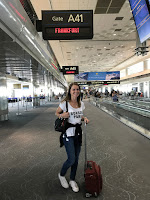La Cultura de Sevilla
Hola from Sevilla!
We started our Saturday on our
rooftop, looking out over Sevilla and eating a little breakfast (i.e.
croissants and biscuits) from our local market.
We strolled to La Catedral de Sevilla, the largest
Gothic church in the world and the 3rd largest church in Europe
after the Vatican (Rome) and St. Paul’s Cathedral (London). It also houses
Spain’s beloved Italian explorer, Christopher Columbus. This Cathedral used to
be a mosque, but was transformed in the 1400s. Construction took nearly 100
years, but the modern-day Cathedral features an ornate high altar, chapels, a
Treasury, and a Court featuring orange trees. While we were there, we went up
the cathedral’s Giralda Tower to get
some wonderful views of Sevilla. The tower has mostly ramps, so our calves got
a pretty solid workout on the way up as we climbed 35 ramps and 17 stairs. Dad
and I stayed a little longer at the top so I could find our apartment – we
found it, but also got a little scared when someone rung the bell to tell us it
was noon!
After our visit, we stopped by
Starbucks to pick up a quick snack. Because it was over 100 degrees again
(yay!), we also got some gelato at our favorite place, called Amorino. (Note: This gelato place has
chains in many big cities – go check it out if you have a chance!) I got a
sorbet rose with a raspberry macaron while the rest of my family got some
regular gelato. While we walked to our next destination, our favorite street
performer (a guy in a clown costume) scared us again.
Next, we decided we’d hit one of
the biggest cultural sites in Sevilla, the Plaza
de los Toros (Sevilla’s bullring). We took an informative guided tour in
both Spanish and English where we learned about the history and tradition
behind Spain’s most (in)famous but controversial events. Sevilla’s Plaza is one
of the oldest – the ring was finished in the 1760s and still hosts
approximately 25 events each year. Our tour took us through four main rooms
covering the 18th century, the “Golden Age” (1900-1920), the
remainder of the 20th century, and the present before we saw the
chapel where matadors pray before fights, the horse stables, and the ring
itself. Even though I had learned a little about bullfighting in school,
learning about the traditions really opened my eyes to what it really is. Many
of the elements of these bullfights are relevant to Spanish culture, but more
importantly, they represent tradition. Tourist tip - if you’re in Spain and
have a chance to go, you should – even if you disagree with it in principle.


After a siesta, we left our
apartment again for another incredible cultural experience. We went to La Casa de Flamenco to see a show
featuring a typical quartet. My dad (fairly accurately) described Sevilla’s
trademark dance as a mixture between passion and swatting bugs away. It’s a
loud, rhythmic, soulful expression featuring a variety of snaps, claps, kicks,
and steps. We had a singer, a guitarist, and two dancers who each performed
individually and as a group. All four of us were inspired by the show, even to
the point that my dad danced through the streets of Sevilla. (He’s convinced he
knows how to do the Flamenco now; my mom’s not so sure!)
We ate dinner at La Bartola, one of the highest-rated
restaurants in the Santa Cruz neighborhood. When we arrived (around 8:15,
customary dinner time for Spaniards), all the tables were taken. Our waiter
promised we would be the next ones seated. He defended the tables multiple
times from other hungry potential consumers. Once we sat down, we tried their
house salad, croquettes, bread, chicken, beef, pork, baby squids, and a
cod/eggplant tower – all was delicious but we’d suggest the beef.
We ended the night by wandering
the Barrio Santa Cruz, Sevilla’s
quaint neighborhood near the Cathedral, passing by churches, flamenco bars, and
multiple restaurants trying to court us for dinner.
QOTD: “This is a bloodsport.” -Mom, referring to the sport of
fighting for the next available table.



























Comments
Post a Comment